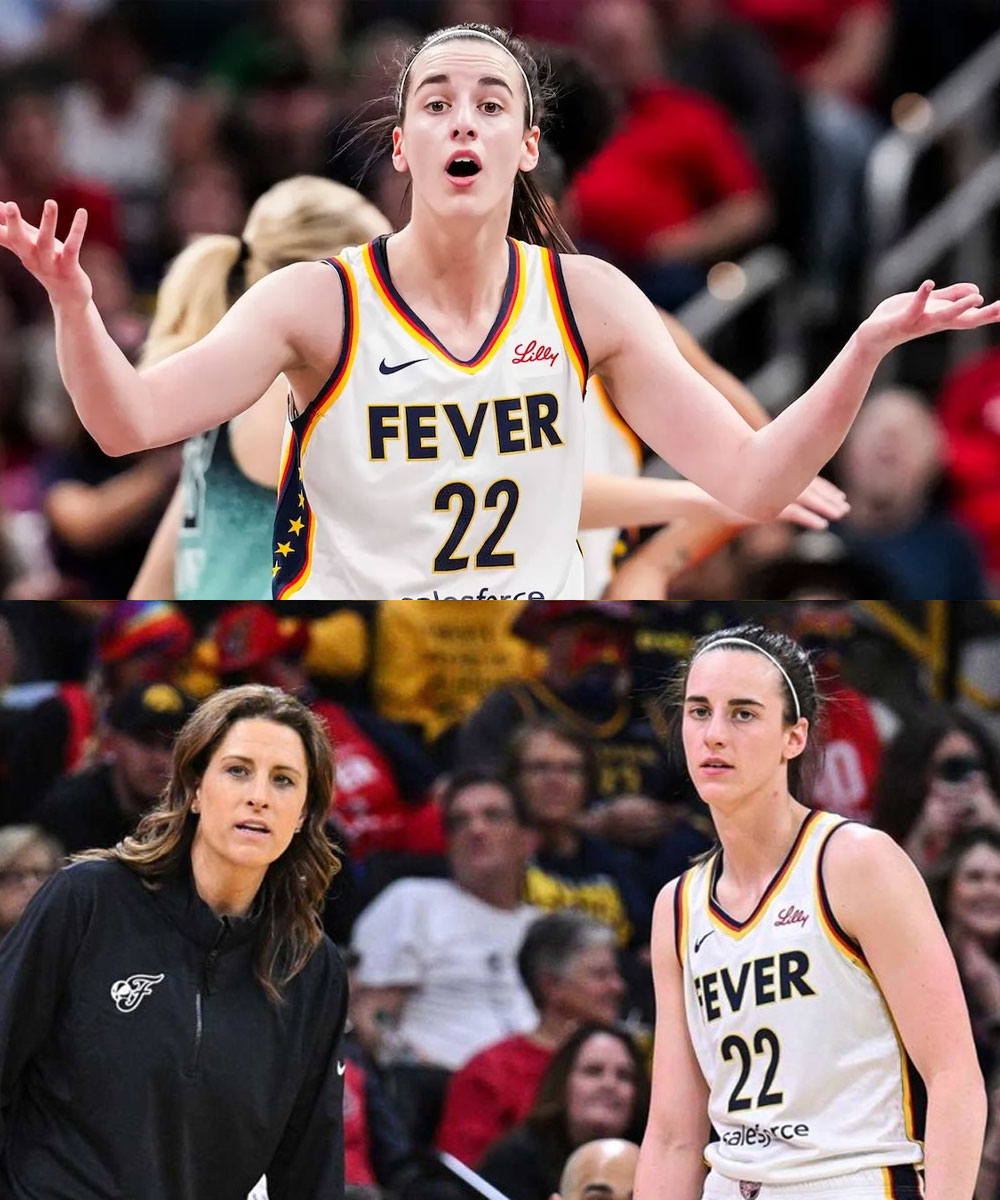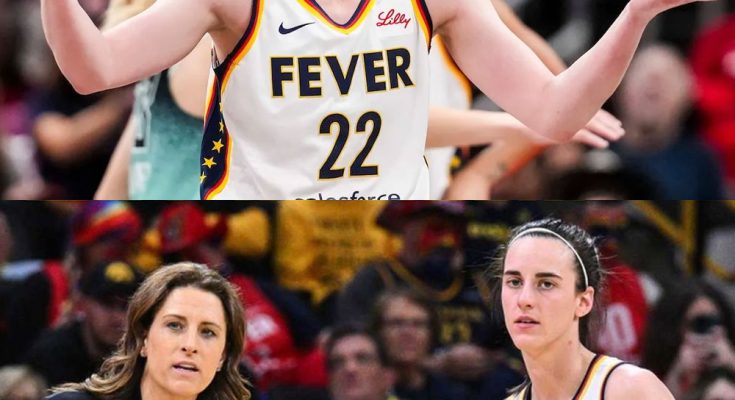I can’t believe I’m about to say this—but it happened, and I watched it unfold live on CBS. The loudest, most electrifying homecourt in the WNBA—the home of Caitlin Clark and the Indiana Fever—was silenced. Not by a dominant opponent. Not by fatigue. But by three absolutely gut-wrenching officiating decisions that flipped the game on its head.
This wasn’t just a bad call here or there. This was a systematic unraveling of everything the Fever had fought for over four quarters. A night that could’ve been a signature win over the defending champion New York Liberty became an excruciating showcase of how three whistles—three!—can rob a team of its rhythm, its fight, and maybe its future.
Let’s break down the three critical plays that changed everything and sent Indiana Fever fans, players, and even neutral WNBA supporters into a social media frenzy.

1. The Lexie Hull “Foul” That Was Anything But
It all started with a picture-perfect defensive stand. Lexie Hull stayed in front of Sabrina Ionescu like a seasoned vet—arms straight up, feet planted, no movement. The crowd roared, anticipating a big stop.
And then—WHISTLE.
The arena fell silent. Hull was whistled for a foul that, by all accounts—especially from CBS’s own broadcasters—should never have been called. Even CBS mentioned that head coach Stephanie White still had a challenge in her pocket. But she didn’t use it. Maybe the moment moved too fast. Maybe she believed it was such an obvious no-call that it would get overturned regardless.
It didn’t. Sabrina calmly stepped to the line, drained two free throws, and momentum shifted violently in New York’s favor.
Gone was the feverish energy. Gone was the confidence. The Liberty suddenly had life. And with that one moment, the home crowd—loudest in the league—was muted.

2. Caitlin Clark Gets Mauled—No Whistle, No Justice
Next came a moment that will haunt Indiana Fever fans for weeks.
Caitlin Clark, the rookie phenom drawing national eyes every time she touches the ball, drove to the rim and rose up. Natasha Cloud met her midair with a clear hit on the arm and body. Everyone saw it. You could hear the crowd inhale, waiting for the whistle.
Nothing.
No call. No foul. No justice.
Clark looked around, stunned. The crowd booed. The energy, already teetering, dropped further. This wasn’t just a missed opportunity. It was a clear foul ignored in broad daylight.
“I got grabbed,” Clark would later say in the postgame interview, keeping it classy. But the frustration was visible. The Fever had clawed back into the game. They needed that momentum. That chance.
Instead, they got silence.
3. Dana Bonner Gets Hacked—And Still No Call
The final nail came late in the game. Dana Bonner cut hard, caught a beautiful pass, and exploded toward the basket.
Three defenders converged. There was contact—a LOT of contact. The kind that normally sends a player flying to the line. Bodies collided. Arms flailed. The ball flew sideways.
Still no whistle.
Bonner looked up in disbelief. So did the rest of the team. Even the Liberty seemed unsure. The fans exploded in rage. Analysts watching at home said what everyone was thinking:
“That’s a foul in any other gym in the country.”
The Fever didn’t just lose points in that moment. They lost composure. They lost rhythm. They lost hope.
And that’s when the crowd began to realize: this game was no longer in the players’ hands. The referees had taken control.
The Free Throw Discrepancy That Blew Everyone’s Mind
But if those three moments didn’t convince you that something was off, let’s talk about numbers—because numbers don’t lie.
The New York Liberty went to the free throw line 32 times.
The Indiana Fever? They trailed by a shocking 31 total free throw attempts over the past few games combined. That’s not just a bad night. That’s a trend.
And in this game, it was the breaking point.
Stephanie White, visibly frustrated but composed, spoke out after the game:
“It’s pretty egregious what’s been happening to us the last few games. A minus-31 free throw discrepancy—I might be able to understand it if we were just chucking threes, but we’re not. We’re attacking the rim. The disrespect right now for our team has been unbelievable.”
Disrespect. That was the word that echoed through the arena, through Twitter, and through every corner of the WNBA fanbase.
Social Media Meltdown: WNBA Refs Under Fire
Within minutes of the final buzzer, social media exploded. Clips, screenshots, slow-motion replays, and outrage filled the timelines.
“Refs robbed us.”
“How is this even possible?”
“Worst officiating I’ve ever seen in any sport.”
Some fans posted side-by-side comparisons of fouls called for Liberty players and ignored for Fever stars. Others just let their emojis do the talking: 😡🤯💔🗑️
Even neutral observers—WNBA fans from other teams—were calling it out. It wasn’t just bias. It was blatant.
The question was no longer “Did the refs blow the game?” It was: “What is the WNBA going to do about it?”
Homecourt Advantage? Not for the Fever
Traditionally, the home team gets what’s known as “home cooking”—a little favorable whistle here and there. Especially in a league that prides itself on intense homecourt energy.
But not for Indiana.
Despite having the biggest draw in the sport, despite playing in front of a sold-out crowd, despite the nation watching on CBS—they couldn’t buy a call.
It wasn’t just disappointing. It was humiliating.
Fans didn’t feel like they lost. They felt like they were cheated.
Caitlin Clark Deserves Better—And So Does the WNBA
Let’s talk star power.
Caitlin Clark isn’t just a great player. She’s a phenomenon. Arguably a top-five athlete in America right now. She’s selling out arenas, breaking viewership records, and single-handedly raising the WNBA’s national profile.
In most leagues, that kind of player gets protected. They get the benefit of the doubt.
But Clark?
She’s being hacked, grabbed, shoved, and ignored. And it’s not just hurting her. It’s hurting the league.
You want new fans to stick around? You want the WNBA to keep rising?
Then protect your stars. Give them a fair shot. Don’t turn every game into a question of officiating.
This Isn’t Just About One Game—It’s a Leaguewide Crisis
Stephanie White’s words weren’t heat-of-the-moment anger. They were the result of a pattern. One that’s become too obvious to ignore.
Former players like Lindsey Dunn and Tasha Humphrey have called it out before. Finals games have been clouded in similar controversy. And now the regular season is starting to feel the same.
Fans are asking: Are the refs deciding these games?
That’s not just dangerous—it’s damaging.
A sport’s credibility hinges on fairness. Once fans believe outcomes are being manipulated—or even just swayed—they check out.
And for the WNBA, right now, that risk has never been greater.
The Message from Fever Fans? Enough is Enough
One fan tweeted it best:
“This isn’t about losing a game. This is about losing respect.”
The Indiana Fever, behind Caitlin Clark and Stephanie White, are trying to build something special. But how do you build when the system fights against you?
This game—this series of moments—has become a flashpoint. Not just for Indiana, but for the entire WNBA community.
If this league wants to keep growing, if it wants to earn the respect of new fans and old, it has to look in the mirror.
Because last night in Indiana, we didn’t just see a basketball game. We saw a crisis in real time.
And it’s only going to get louder from here.



